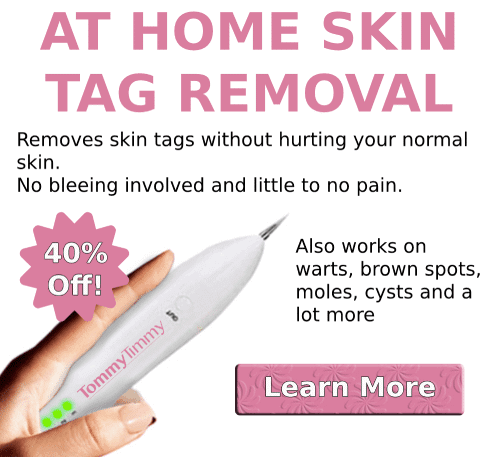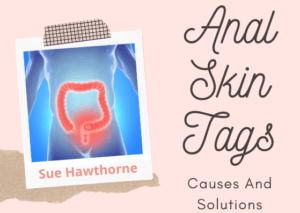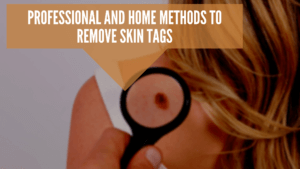Skin tags are common benign skin growths that can appear anywhere on the body. While they may not be a serious health concern, many people choose to remove them for cosmetic reasons.
But is it possible to cut off a skin tag yourself?
This article will explore whether or not this is a safe and effective way to get rid of these bothersome areas of excess skin.
Skin tags can range in size from a few millimeters to over an inch long and occur most often in parts of the body where there is friction such as around the neck, underarm area, eyelids, upper chest, and groin region. Although harmless, some people find their presence unsightly and seek ways to get rid of them without having to visit a doctor’s office.
One popular method people use in an attempt to eliminate their skin tags is by cutting them off themselves with scissors or other sharp objects.
While you might think self-removal sounds like a simple solution, it’s important to consider if it is actually safe and effective before taking matters into your own hands. In order to make sure you know what risks are associated with cutting off skin tags at home, read on as we dive deeper into this topic!
Should You Cut Off A Skin Tag?
Generally speaking, no – it isn’t recommended. Cutting or removing a skin tag yourself can lead to infection and could even cause pain or bleeding. It’s best to let your doctor handle any removal procedure if necessary. Your doctor may recommend freezing or burning the tag depending on its size and location.
The most important thing is to keep an eye on the skin tag so that you know when something changes with it – whether in size or shape – which would require medical attention from your doctor as soon as possible. All things considered, it’s usually better to leave skin tags alone unless they become an issue due to their size or placement; then seek advice from a healthcare professional who can provide safe and effective treatment options.
Contents
Professional Procedures For Cutting Off A Skin Tag
Nowadays, many medical professionals offer a variety of options when it comes to cutting off a skin tag.
There are surgical removal techniques such as excision or ligation. In excision surgery, a scalpel is used to cut off the base of the tag while ligation uses stitches to tie off blood vessels supplying nutrients to the area in order to starve the tag and make it fall away.
While both methods are highly effective at removing skin tags permanently, they do carry risks such as bleeding and infection so should only be done by qualified medical personnel.
The Risks Involved In Cutting Off A Skin Tag
According to the American Academy of Dermatology, about 25% of adults have one or more skin tags. This is a staggering amount and shows that this is an issue for many people. While cutting off a skin tag may seem like an easy solution, there are risks involved with taking matters into your own hands.
Firstly, when attempting to cut it off yourself you could cause infection in the area if not done properly. It’s important to use clean scissors and sterilize them using rubbing alcohol before making any incisions. You should also make sure the area is clean prior to cutting as well.
If you don’t take these precautions, chances are that you will be introducing bacteria into the wound which can lead to inflammation and even further complications down the road such as scarring or discoloration.
Secondly, if the skin tag isn’t totally removed then it can start growing back over time either thicker or larger than before.
Additionally, if you’re not careful enough while removing it then you run the risk of causing unnecessary bleeding or tissue damage near the affected area which can result in difficulty healing afterwards.
The best way to avoid this kind of complication is by seeking professional help from a dermatologist instead so that they can ensure proper removal without damaging surrounding tissues and reduce chances of recurrence later on.
Aftercare Instructions For Cutting Off A Skin Tag
The most important part of aftercare is keeping the area clean and dry. Immediately following the procedure, use some warm water and mild soap to gently wash around the wound before patting dry with a sterile cloth or bandage. You may also want to apply an antibiotic ointment like Neosporin if you have any on hand.
Over time, make sure to keep up with regular check-ins of the area for signs of infection such as redness, swelling, warmth, pus formation or fever. If any of these symptoms arise then seek medical attention immediately.
Additionally, avoid using any over-the-counter creams or lotions until the area has fully healed in order to prevent further irritation from occurring. By taking these precautions into account during your recovery period, you will be able to heal faster without major complications!
When To See A Doctor
Surprisingly, there is a time when you should not attempt to cut off your own skin tag! Yes, it’s true – even with the right aftercare instructions and tools, sometimes it’s best to just leave them alone. When should you see a doctor? Let’s take a look.
If the area appears infected or inflamed in any way, if the skin tag is located near an eye or mouth, or if the growths have multiple stems then you’re better off seeking professional help before attempting self-removal.
Additionally, if you don’t feel comfortable handling surgical scissors yourself – which let’s face it can be intimidating for some people – then make sure to book an appointment with your healthcare provider as soon as possible.
Don’t risk making matters worse by taking on something that feels out of your wheelhouse; instead trust medical professionals who know exactly what they’re doing and can provide safe results without putting your health at further risk.
What Happened When I Cut Off A Skin Tag
When I decided to take matters into my own hands and cut off a skin tag, it seemed like an easy solution. But what I didn’t know was the consequences of such a decision could have been dire. Like Pandora opening her famous box, I soon found out that cutting off a skin tag had implications far beyond anything I expected.
Just as with any wound, there was pain and bleeding when the skin tag was removed. To make matters worse, because the area where the skin tag was located is often in a sensitive spot, infection may occur if not treated properly.
Even though you can use over-the-counter products or home remedies for disinfecting the site and dealing with inflammation, it’s still important to get advice from your doctor before attempting this type of self-treatment.
In addition to potential infections caused by improper care after removal, scarring is another significant risk factor associated with cutting off a skin tag yourself. The severity of these scars depends on how deep the incision was made and how much tissue damage occurred during the procedure.
To avoid long-term effects of disfigurement or discomfort due to raised scars, consulting with your medical practitioner first is always recommended before taking action on your own.
In summary, cutting off a skin tag can be an effective and safe way to remove it. It is important to ensure that the area is sterilized properly before beginning, as any type of infection could cause complications.
Additionally, one should take extra caution when performing this procedure on sensitive areas such as near the eyes or genitals. When done carefully and with proper precautions, it can be a successful approach for managing skin tags.
When considering whether to cut off a skin tag at home, it’s crucial to remember that results may vary from person-to-person. Some people have reported success using this method while others have experienced issues like bleeding or scarring afterwards. If you do decide to go ahead with self removal, make sure to research all relevant safety guidelines beforehand so you know what kind of risks are involved.
Conclusion
In conclusion, skin tags may be unsightly but they are typically harmless. If you decide to cut off a skin tag at home or have it professionally removed, it is important to understand the risks involved and take necessary precautions for safe aftercare to avoid any further complications.
Although there’s no one-size-fits-all answer as to whether cutting off a skin tag is right for you, if done correctly, this can be an effective way of removing them – like the icing on a cake!
Ultimately, it’s best to consult with your doctor so that they can help determine the best course of action suited specifically for your condition.









